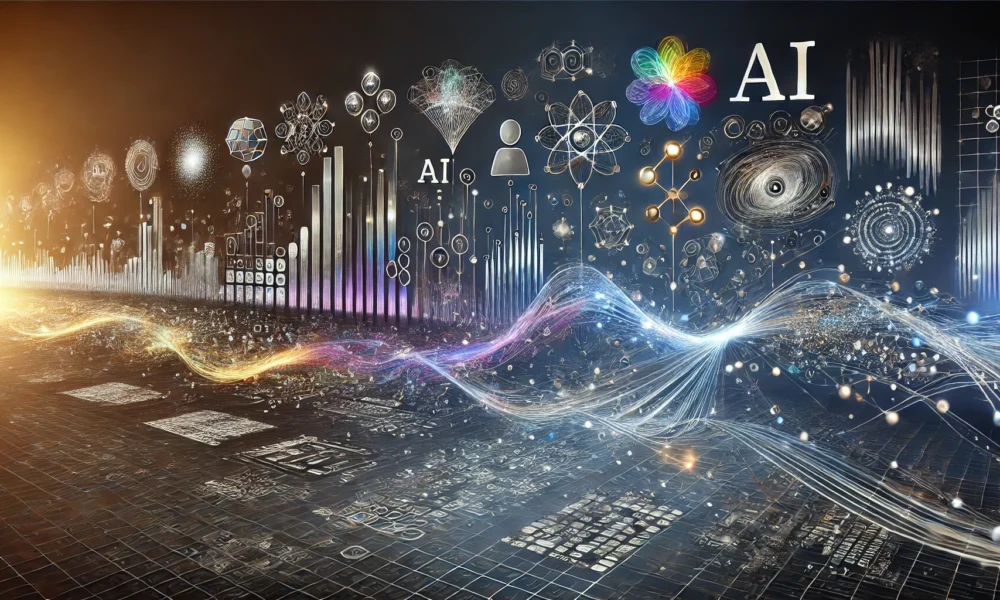The Revolutionary Impact of Artificial Intelligence (AI) on Industries
Artificial Intelligence (AI) is no longer just a science-fiction concept. It is now a technology that has transformed human life and has the potential to reshape many industries. AI can change many disciplines, from chatbots helping in customer service to advanced systems that accurately diagnose diseases. But, even with these significant achievements, many businesses find using AI in their daily operations hard.
While researchers and tech companies are advancing AI, many businesses struggle to keep up. Challenges such as the complexity of integrating AI, the shortage of skilled workers, and high costs make it difficult for even the most advanced technologies to be adopted effectively. This gap between creating AI and using it is not just a missed chance; it is a big challenge for businesses trying to stay competitive in today’s digital world.
Understanding the reasons behind this gap, identifying the barriers that prevent businesses from fully utilizing AI, and finding practical solutions are essential steps in making AI a powerful tool for growth and efficiency across various industries.
Unleashing AI’s Potential Through Rapid Technological Advancements
Over the past decade, AI has achieved remarkable technological milestones. For example, OpenAI’s GPT models have demonstrated the transformative power of generative AI in areas like content creation, customer service, and education. These systems have enabled machines to communicate almost as effectively as humans, bringing new possibilities in how businesses interact with their audiences. At the same time, advancements in computer vision have brought innovations in autonomous vehicles, medical imaging, and security, allowing machines to process and respond to visual data with precision.
AI is no longer confined to niche applications or experimental projects. As of early 2025, global investment in AI is expected to reach an impressive $150 billion, reflecting a widespread belief in its ability to bring innovation across various industries. For example, AI-powered chatbots and virtual assistants transform customer service by efficiently handling inquiries, reducing the burden on human agents, and improving overall user experience. AI is pivotal in saving lives by enabling early disease detection, personalized treatment plans, and even assisting in robotic surgeries. Retailers employ AI to optimize supply chains, predict customer preferences, and create personalized shopping experiences that keep customers engaged.
Despite these promising advancements, such success stories remain the exception rather than the norm. While large companies like Amazon have successfully used AI to optimize logistics and Netflix tailors recommendations through advanced algorithms, many businesses still struggle to move beyond pilot projects. Challenges such as limited scalability, fragmented data systems, and a lack of clarity on implementing AI effectively prevent many organizations from realizing its full potential.
A recent study reveals that 98.4% of organizations intend to increase their investment in AI and data-driven strategies in 2025. However, around 76.1% of most companies are still in the testing or experimental phase of AI technologies. This gap highlights companies’ challenges in translating AI’s groundbreaking capabilities into practical, real-world applications.
As companies work to create a culture driven by AI, they are focusing more on overcoming challenges like resistance to change and shortages of skilled talent. While many organizations are seeing positive results from their AI efforts, such as better customer acquisition, improved retention, and increased productivity, the more significant challenge is figuring out how to scale AI effectively and overcome the obstacles. This highlights that investing in AI alone is not enough. Companies must also build strong leadership, proper governance, and a supportive culture to ensure their AI investments deliver value.
Overcoming Obstacles to AI Adoption
Adopting AI comes with its own set of challenges, which often prevent businesses from realizing its full potential. These hurdles are challenging but require targeted efforts and strategic planning to overcome.
One of the biggest obstacles is the lack of skilled professionals. Implementing AI successfully requires expertise in data science, machine learning, and software development. In 2023, over 40% of businesses identified the talent shortage as a key barrier. Smaller organizations, in particular, struggle due to limited resources to hire experts or invest in training their teams. To bridge this gap, companies must prioritize upskilling their employees and fostering partnerships with academic institutions.
Cost is another major challenge. The upfront investment required for AI adoption, including acquiring technology, building infrastructure, and training employees—can be huge. Many businesses hesitate to take the steps without precise projections of ROI. For example, an e-commerce platform might see the potential of an AI-driven recommendation system to boost sales but find the initial costs prohibitive. Pilot projects and phased implementation strategies can provide tangible evidence of AI’s benefits and help reduce perceived financial risks.
Managing data comes with its own set of challenges. AI models perform well with high-quality, well-organized data. Still, many companies struggle with problems like incomplete data, systems that don’t communicate well with each other, and strict privacy laws like GDPR and CCPA. Poor data management can result in unreliable AI outcomes, reducing trust in these systems. For example, a healthcare provider might find combining radiology data with patient history difficult because of incompatible systems, making AI-driven diagnostics less effective. Therefore, investing in strong data infrastructure ensures that AI performs reliably.
Additionally, the complexity of deploying AI in real-world settings poses significant hurdles. Many AI solutions excel in controlled environments but struggle with scalability and reliability in dynamic, real-world scenarios. For instance, predictive maintenance AI might perform well in simulations but faces challenges when integrating with existing manufacturing systems. Ensuring robust testing and developing scalable architectures are critical to bridging this gap.
Resistance to change is another challenge that often disrupts AI adoption. Employees may fear job displacement, and leadership might hesitate to overhaul established processes. Additionally, lacking alignment between AI initiatives and overall business objectives often leads to underwhelming results. For example, deploying an AI chatbot without integrating it into a broader customer service strategy can result in inefficiencies rather than improvements. To succeed, businesses need clear communication about AI’s role, alignment with goals, and a culture that embraces innovation.
Ethical and regulatory barriers also slow down AI adoption. Concerns around data privacy, bias in AI models, and accountability for automated decisions create hesitation, particularly in industries like finance and healthcare. Companies must evolve regulations while building trust through transparency and responsible AI practices.
Addressing Technical Barriers to AI Adoption
Cutting-edge AI models often require significant computational resources, including specialized hardware and scalable cloud solutions. For smaller businesses, these technical demands can be prohibitive. While cloud-based platforms like Microsoft Azure and Google AI provide scalable options, their costs remain challenging for many organizations.
Moreover, high-profile failures such as Amazon’s biased recruiting tool, scrapped after it favored male candidates over female applicants, and Microsoft’s Tay chatbot, which quickly began posting offensive content, have eroded trust in AI technologies. IBM Watson for Oncology also faced criticism when it was revealed that it made unsafe treatment recommendations due to being trained on a limited dataset. These incidents have highlighted the risks associated with AI deployment and contributed to a growing skepticism among businesses.
Lastly, the market’s readiness to adopt advanced AI solutions can be a limiting factor. Infrastructure, awareness, and trust in AI are not uniformly distributed across industries, making adoption slower in some sectors. To address this, businesses must engage in education campaigns and collaborate with stakeholders to demonstrate the tangible value of AI.
Strategic Approaches for Successful AI Integration
Integrating AI into businesses requires a well-thought-out approach that aligns technology with organizational strategy and culture. The following guidelines outline key strategies for successful AI integration:
- Define a Clear Strategy: Successful AI adoption begins with identifying specific challenges that AI can address, setting measurable goals, and developing a phased roadmap for implementation. Starting small with pilot projects helps test the feasibility and prove AI’s value before scaling up.
- Start with Pilot Projects: Implementing AI on a small scale allows businesses to evaluate its potential in a controlled environment. These initial projects provide valuable insights, build stakeholder confidence, and refine approaches for broader application.
- Promote a Culture of Innovation: Encouraging experimentation through initiatives like hackathons, innovation labs, or academic collaborations promotes creativity and confidence in AI’s capabilities. Building an innovative culture ensures employees are empowered to explore new solutions and embrace AI as a tool for growth.
- Invest in Workforce Development: Bridging the skill gap is essential for effective AI integration. Providing comprehensive training programs equips employees with the technical and managerial skills needed to work alongside AI systems. Upskilling teams ensure readiness and enhance collaboration between humans and technology.
AI can transform industries, but achieving this requires a proactive and strategic approach. By following these guidelines, organizations can effectively bridge the gap between innovation and practical implementation, unlocking the full potential of AI.
Unlocking AI’s Full Potential Through Strategic Implementation
AI has the potential to redefine industries, solve complex challenges, and improve lives in profound ways. However, its value is realized when organizations integrate it carefully and align it with their goals. Success with AI requires more than just technological expertise. It depends on promoting innovation, empowering employees with the right skills, and building trust in their capabilities.
While challenges like high costs, data fragmentation, and resistance to change may seem overwhelming, they are opportunities for growth and progress. By addressing these barriers with strategic action and a commitment to innovation, businesses can turn AI into a powerful tool for transformation.
Cutting-edge AI models often require significant resources, expertise, and infrastructure to deploy and maintain, making them inaccessible to many businesses that lack the necessary capabilities.
Businesses can overcome these challenges by partnering with AI vendors, investing in internal AI expertise, and leveraging cloud-based AI services to access cutting-edge models without the need for extensive infrastructure.
Adopting cutting-edge AI models can lead to improved decision-making, increased efficiency, and reduced costs through automation and optimization of business processes.
Yes, there are risks such as bias in AI models, privacy concerns related to data usage, and potential job displacement due to automation. It is important for businesses to carefully consider and mitigate these risks before deploying cutting-edge AI models.
Businesses can stay updated by attending industry conferences, following AI research publications, and engaging with AI vendors and consultants to understand the latest trends and developments in the field.











